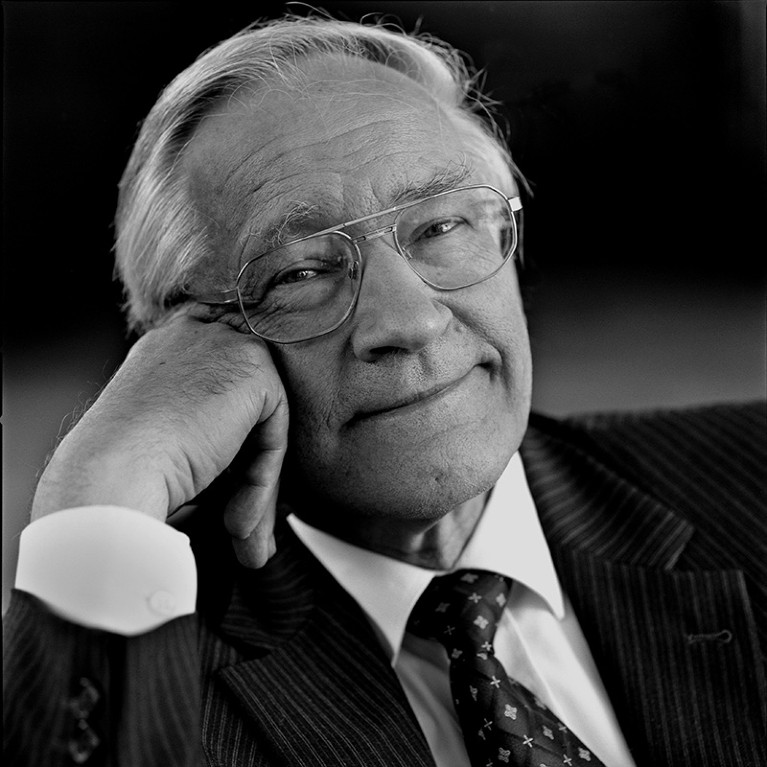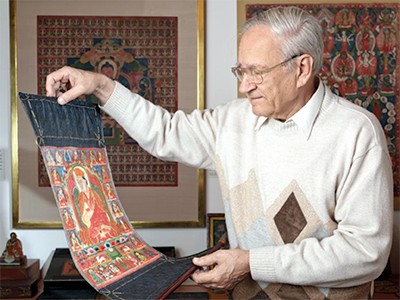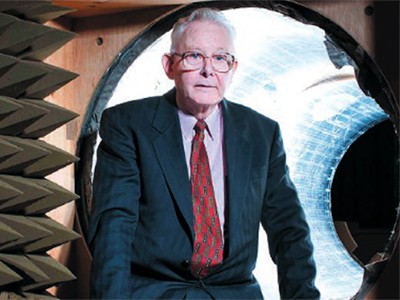
Credit: Tina Ruisinger/Visum/eyevine
Richard R. Ernst turned applications of nuclear magnetic resonance (NMR) into methods for daily use in chemistry, structural biology and medical diagnosis. His introduction of Fourier transform-nuclear magnetic resonance (FT-NMR) in the 1960s paved the way for magnetic resonance imaging (MRI) to be widely used in medical diagnosis and in materials research.
As well as gaining him the Nobel Prize in Chemistry in 1991, Ernst’s work underpinned the achievements rewarded by the two NMR Nobel prizes of the twenty-first century so far — mine included. He has died, aged 87.
Richard Robert Ernst was born in Winterthur, Switzerland. His family was part of the city’s establishment, with a history stretching back at least 500 years. His father taught architecture at the Winterthur ‘Technikum’ (today the University of Applied Sciences) and was a high-ranking officer in the Swiss army. In this distinguished milieu, musical gatherings had an important place; Richard played the cello. His plans to become a composer were set aside at 13, when he found a box of chemicals in the attic, left by a late uncle, and began doing experiments. After studying chemistry at the Swiss Federal Institute of Technology (ETH) in Zurich, he pursued doctoral studies in the new field of NMR.
Shortly after the Second World War, Felix Bloch and Edward Mills Purcell had described NMR spectroscopy, sharing the 1952 Nobel Prize in Physics. The principle is this: in a magnetic field, the moments of certain atomic nuclei of a substance come into alignment. Applying radio-frequency irradiation perturbs this alignment, causing the atoms to give off electromagnetic signals that are unique to the chemical composition and molecular structure of the substance.
Soon after its discovery, NMR became widely used in physics, for example in particle physics, solid-state physics and in studies of phase transitions. Applications as an analytical tool in chemistry started in the 1950s with continuous-wave NMR experiments, which had limited impact because their sensitivity was too low.
Working in the mid-1960s at the then leading manufacturer of NMR instrumentation, the Varian Company in Palo Alto, California, Ernst experimented with applying a single, hard pulse that excites the entire spectrum, instead of sweeping the NMR spectra with weak continuous irradiation. He then subjected the resulting signal to Fourier transformation to generate a high-resolution spectrum.
Neither the materials used in NMR instruments nor the computer facilities of the 1960s were up to the demands of the new technique. So it took another decade before FT-NMR found applications in chemistry and structural biology. FT-NMR also provided the foundation for the more-informative 2D NMR in the late 1970s; related mathematical procedures made MRI efficient for medical diagnosis.
In the late 1960s, Ernst returned to ETH Zurich, where he spent the rest of his career. Over four decades, he inspired generations of scientists as a professor, and as a lecturer around the world.
His graduate students and postdoctoral fellows witnessed him diving again and again into the depths of a theory or a physical-chemical effect. In great mathematical detail and with unique didactic skills, using his arms to illustrate how the magnetization in an NMR sample behaves under the influence of radio-frequency fields, say, he would generate rigorous formalisms to capture all nuances of a phenomenon. Thanks to the Ernst magic, the NMR community evolved from a few hundred scientists in the early 1970s to gatherings of thousands in a range of specialized areas of NMR today.
Ernst described himself as a “work-addict”. A toolmaker, he liked to provide others with new ways to solve problems. Yet he also believed that scientists should have a wide range of interests outside their field. He played the cello throughout his life, and had an encyclopedic knowledge of classical music. In his later years, he wrote a frank and insightful autobiography (translated as Searching and Researching, published this year).
On their return from California to Switzerland in 1968, Ernst and his wife travelled to Tibet, where they became fascinated by the local scroll paintings, and in the following decades they assembled a rich collection of Tibetan art. Ernst’s joy in this culture is touchingly apparent in his autobiography, which features beautiful illustrations of the works. After he retired in 1998, Ernst devoted his time and energy, as well as the Nobel prize money, to expanding this collection. In his home, he used cutting-edge spectroscopic techniques (not NMR!) to examine the paint on his precious Tibetan scrolls to trace their provenance.
As a colleague on the faculty of ETH Zurich, I had the privilege of a close scientific collaboration with Ernst from 1976 to 1986, which resulted in the introduction of multi-dimensional NMR to chemistry laboratories and to structural biology. I knew Richard as a strikingly intelligent, conscientious and gentle colleague and friend. Together with so many who are indebted to him for having enriched their scientific lives, I keep fond memories of the good times spent with this great scientist.



 A man of many dimensions
A man of many dimensions
 Nicolaas Bloembergen (1920–2017)
Nicolaas Bloembergen (1920–2017)
 Peter Mansfield (1933–2017)
Peter Mansfield (1933–2017)








